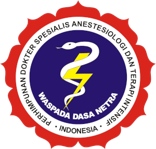Spinal Anesthesia in a Patient with Complete Placenta Previa and Suspected Placenta Accreta Undergoing Cesarean Hysterectomy: Is it Possible?
Abstract
Background : Placenta accreta spectrum (PAS) is a major contributor to peripartum hemorrhage and an important cause of maternal morbidity and mortality. Anesthetic management in such cases requires planning to minimize complications.
Case Illustration : This report describes the perioperative management of a 39-year-old woman, gravida 4 para 2 at 35 weeks' gestation, who was diagnosed with complete placenta previa and suspected placenta accreta based on ultrasonography and clinical presentation. She underwent cesarean section followed by hysterectomy under spinal anesthesia using 0.5% hyperbaric bupivacaine (12 mg) and clonidine (30 mcg) at the L4-L5 interspace. Intraoperative monitoring included non-invasive blood pressure, ECG, SpO₂, EtCO₂, body temperature, urine output, and serial blood glucose. The operation lasted approximately 2.5 hours with an estimated blood loss of 2000 ml. Fluid resuscitation consisted of crystalloids, albumin, and packed red cells, achieving a calculated fluid replacement of 11.1 mL/kg/h. The baby was delivered in good condition with an APGAR score of 7 and 9 at 1 and 5 minutes, respectively. Postoperative recovery within 24 hours was stable, with minimal pain and no complications.
Conclusion : This case demonstrates that with appropriate preparation, spinal anesthesia can be safely and effectively used in selected patients with PAS.
Keywords
Full Text:
PDFReferences
1. Jauniaux E, Ayres-de-Campos D, Duncombe G, Klaritsch P, Chantraine F, Kingdom J, et al. FIGO consensus guidelines on placenta accreta spectrum disorders: Introduction. Int J Gynaecol Obstet [Internet]. 2018 Mar 1 [cited 2025 Apr 17];140(3):261–4. Available from: https://pubmed.ncbi.nlm.nih.gov/29405322/
2. Jauniaux E, Chantraine F, Silver RM, Langhoff-Roos J, Duncombe G, Klaritsch P, et al. FIGO consensus guidelines on placenta accreta spectrum disorders: Epidemiology. Int J Gynaecol Obstet [Internet]. 2018 Mar 1 [cited 2025 Apr 17];140(3):265–73. Available from: https://pubmed.ncbi.nlm.nih.gov/29405321/
3. Aryananda RA. Resurgence of placenta accreta in Indonesia. Majalah Obstetri & Ginekologi [Internet]. 2018 Feb 9 [cited 2025 Apr 17];26(3):98–9. Available from: https://e-journal.unair.ac.id/MOG/article/view/10925
4. Abousifein M, Shishkina A, Leyland N. Addressing Diagnosis, Management, and Complication Challenges in Placenta Accreta Spectrum Disorder: A Descriptive Study. J Clin Med [Internet]. 2024 May 28 [cited 2025 Apr 17];13(11). Available from: http://www.ncbi.nlm.nih.gov/pubmed/38892867
5. Sentilhes L, Kayem G, Chandraharan E, Palacios-Jaraquemada J, Jauniaux E, Duncombe G, et al. FIGO consensus guidelines on placenta accreta spectrum disorders: Conservative management. International Journal of Gynecology and Obstetrics. 2018 Mar 1;140(3):291–8.
6. Alwatban S, Ibrahim LM, Borges BCR, Miller S. Anesthetic Management of Placenta Accreta Spectrum Disorders: A Narrative Review. Journal of Obstetric Anaesthesia and Critical Care [Internet]. 2025 Jan [cited 2025 Apr 17];15(1):12–22. Available from: https://www.researchgate.net/publication/388751760_Anesthetic_Management_of_Placenta_Accreta_Spectrum_Disorders_A_Narrative_Review
7. Matsuzaki S, Mandelbaum RS, Sangara RN, McCarthy LE, Vestal NL, Klar M, et al. Trends, characteristics, and outcomes of placenta accreta spectrum: a national study in the United States. Am J Obstet Gynecol. 2021 Nov 1;225(5):534.e1-534.e38.
8. Jauniaux E, Bunce C, Grønbeck L, Langhoff-Roos J. Prevalence and main outcomes of placenta accreta spectrum: a systematic review and meta-analysis. Am J Obstet Gynecol. 2019 Sep 1;221(3):208–18.
9. Guo Z, Han X, Zheng W, Yang H, Ma J. Placenta Accreta Spectrum Among Multiple Gestation: A Retrospective Analysis Based on a Chinese Population. Front Endocrinol (Lausanne) [Internet]. 2022 May 18 [cited 2025 Apr 17];13:862785. Available from: www.frontiersin.org
10. Sng BL, Han NLR, Leong WL, Sultana R, Siddiqui FJ, Assam PN, et al. Hyperbaric vs. isobaric bupivacaine for spinal anaesthesia for elective caesarean section: a Cochrane systematic review. Anaesthesia [Internet]. 2018 Apr 1 [cited 2025 Apr 17];73(4):499–511. Available from: https://onlinelibrary.wiley.com/doi/full/10.1111/anae.14084
11. Paganelli MA, Popescu GK. Actions of Bupivacaine, a Widely Used Local Anesthetic, on NMDA Receptor Responses. The Journal of Neuroscience [Internet]. 2015 Jan 14 [cited 2025 Apr 17];35(2):831. Available from: https://pmc.ncbi.nlm.nih.gov/articles/PMC4293426/
12. Prabhakar A, Lambert T, Kaye RJ, Gaignard SM, Ragusa J, Wheat S, et al. Adjuvants in clinical regional anesthesia practice: A comprehensive review. Best Pract Res Clin Anaesthesiol [Internet]. 2019 Dec 1 [cited 2025 Apr 17];33(4):415–23. Available from: https://pubmed.ncbi.nlm.nih.gov/31791560/
13. Bajwa BS, Singh AP, Rekhi AK. Comparison of intrathecal clonidine and fentanyl in hyperbaric bupivacaine for spinal anesthesia and postoperative analgesia in patients undergoing lower abdominal surgeries. Saudi J Anaesth [Internet]. 2017 Jan 1 [cited 2025 Apr 17];11(1):37. Available from: https://pmc.ncbi.nlm.nih.gov/articles/PMC5292850/
14. Srinivas DB, Lakshminarasimhaiah G. Comparison of subcutaneous dexmedetomidine versus clonidine as an adjuvant to spinal anesthesia: A randomized double blind control trial. Local Reg Anesth [Internet]. 2019 [cited 2023 Feb 13];12:29–36. Available from: https://www.tandfonline.com/action/journalInformation?journalCode=dlra20
15. Benhamou D, Thorin D, Brichant JF, Dailland P, Milon D, Schneider M. Intrathecal Clonidine and Fentanyl with Hyperbaric Bupivacaine Improves Analgesia During Cesarean Section. Anesth Analg. 1998 Sep;87(3):609–13.
16. Bajwa SS, Bajwa S, Kaur J, Singh A, Singh A, Parmar S. Prevention of hypotension and prolongation of postoperative analgesia in emergency cesarean sections: A randomized study with intrathecal clonidine. Int J Crit Illn Inj Sci. 2012;2(2):63.
17. Reale SC, Farber MK. Management of patients with suspected placenta accreta spectrum. BJA Educ [Internet]. 2021 Feb 1 [cited 2025 Apr 17];22(2):43. Available from: https://pmc.ncbi.nlm.nih.gov/articles/PMC8749385/
18. Sudhakaran Nair G, Mounir Soliman L, Maheshwari K, Sakr Esa WA. Importance of Vigilant Monitoring After Continuous Nerve Block: Lessons From a Case Report. Ochsner J [Internet]. 2013 [cited 2025 Apr 17];13(2):267. Available from: https://pmc.ncbi.nlm.nih.gov/articles/PMC3684339/
Refbacks
- There are currently no refbacks.








